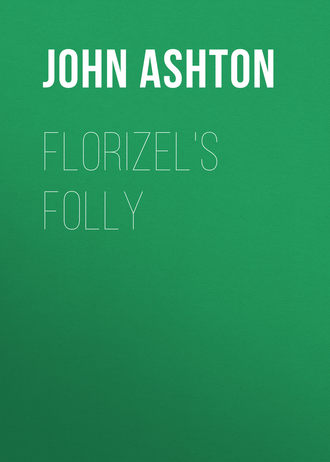 полная версия
полная версияFlorizel's Folly
13
Heavy ordnance, which, in the fifteenth century, could carry stone balls of 200 lb. weight.
14
Or caliver, a kind of harquebuse or musket – the lightest firearm, except the pistol, and it was used without a rest.
15
This hardly agrees with Lee's account (p. 475), who says he 'was conducted at last to the house of a Mrs. Maunsell of Ovingdean, by Lord Wilmot and Colonel Gunter… At Ovingdean the King lay concealed for a few days, as local tradition still relates, within a false wall or partition, while his friends were contriving the best means for his escape to France.'
16
Tattersal.
17
Fécamp.
18
The spelling of the MS. has been modernized.
19
'The Brighton Ambulator,' by C. Wright, London, 1818, p. 25.
20
'Journal of the Reign of King George the Third, from the Year 1771 to 1783,' by Horace Walpole, London, 1859, vol. ii., p. 416.
21
Ibid., p. 449.
22
Walpole, vol. ii., p. 457.
23
Walpole, vol. ii., p. 480.
24
Walpole, vol. ii., p. 502.
25
Vol. ii., p. 446.
26
'Memoirs of George IV.,' by Robert Huish, 8vo., vol. i., p. 80; London, 1831.
27
Vol. i., p. 97, etc.
28
Huish, vol. i., 164.
29
Gentleman's Magazine, 1824, part i., 457, 458.
30
Morning Herald, July 27.
31
Parker's General Advertiser, July 28.
32
Morning Herald, August 9.
33
Morning Herald, August 10.
34
Ibid., August 21.
35
Morning Herald, September 9.
36
Ibid., August 27.
37
Sir Cecil Wray, one of the candidates.
38
Morning Post, July 8, 1785.
39
The lessee and manager.
40
The builders have, since last year, erected a row of houses on the Steyne, with bricks of these colours, in compliment, I imagine, to the Prince's uniform.
41
Whig.
42
'Memoirs of George IV.,' vol. i., p. 125.
43
'Memoirs of Mrs. Fitzherbert,' etc., by the Hon. Charles Langdale; London, 1856, 8vo., p. 115.
44
At this time the great mooncalf would go to Fox's house at St. Ann's Hill, near Chertsey, and there blubber his love-woes into the sympathizing ears of Bridget Cane, alias Armistead, or Armstead, a woman of good manners and some education, who was said to have been waiting-woman to Mrs. Abington, the actress, but who was then Fox's mistress, and afterwards his wife.
45
It is said that the Rev. Mr. Burt, of Twickenham, on his death-bed acknowledged marrying the Prince and Mrs. Fitzherbert, and that he received £500 for his fee.
46
She was married in her own drawing-room.
47
Langdale's 'Memoirs of Mrs. Fitzherbert,' p. 141.
48
By Mrs. Centlivre.
49
By George Colman and D. Garrick.
50
Mistress of George II.
51
This is the first instance I have met with in which it is so called. – J. A.
52
'Memoirs of the Court and Cabinets of George III.,' by the Duke of Buckingham and Chandos; London, 1853, vol. ii., p. 11.
53
'Life of George IV.,' by Percy Fitzgerald; London, 1881, 8vo., vol. i., p. 238.
54
By Mrs. Centlivre, 1714. Revived by Garrick in 1757.
55
'A Review of the Conduct of the Prince of Wales in his various transactions with Mr. Jefferys,' by N. Jefferys; London, 1806, 8vo., eighth edition.
56
The Prince's former jeweller.
57
'Memoirs of George IV.,' vol. i., p. 266.
58
Gillray caricatured them on November 1, 1791, as 'Les Trois Magots' – The Three Scamps.
59
An allusion to Lord Barrymore's country house at Wargrave, near Maidenhead.
60
'Reminiscences of Henry Angelo,' etc.; London, 1830, 8vo.
61
Ibid., vol. ii., p. 94.
62
'Reminiscences of Henry Angelo,' etc.; London, 1830, 8vo., vol. ii., p. 80.
63
Captain Gronow's 'Last Recollections'; London, 1866, 8vo., p. 97.
64
Gillray caricatured him (May, 1792) in 'Le Cochon et ses deux Petites,' where, holding a tumbler of wine in his hand, he is toying with two very fleshly ladies.
65
'The Clubs of London,' etc.; London, 1828, 8vo., vol. ii. p. 27.
66
One mile from St. Leonards Station, and two miles west of Hastings. It is supposed to be the landing-place of Julius Cæsar.
67
'The Emigrants: a Poem,' by Charlotte Smith; London, 1793, 4to., p. 7.
68
She was disguised in male attire.
69
Lady Archer and Mrs. Hobart, both notorious keepers of high-class faro-tables.
70
Gentleman's Magazine, vol. lxiii., part ii., p. 785.
71
'Diaries and Correspondence of James Harris, first Earl of Malmesbury;' London, 1844, vol. ii., p. 450, etc.
72
Anna Maria Crouch, actress and famous singer; born 1763, died 1805. Separated from her husband in 1791.
73
All notorious gamblers and keepers of faro-tables.
74
'The New Brighton Guide;' London, 1796, 8vo., p. 16.
75
'New Brighton Guide,' 1796.
76
An arrangement which was satisfactorily effected.
77
On June 19, 1811.
78
On June 1, 1812, Town Talk published a satirical print, Worse and Worse, or the Sports of the 19th Century.' Mrs. Fitzherbert and Lady Hertford are playing at shuttlecock with the Prince of Wales's feathers. Mrs. F. says, 'This shuttlecock is too light for me. I'll have no more to do with it.' Lady H. calls out, 'You have play'd with it till you are tired, but it suits me to a nicety; the game's mine. Y – h, take care of the shuttlecock.' Lord Yarmouth, who is behind Mrs. F., says, 'O yes, Ma'am, I'll take care of the shuttlecock, I warrant you.'
79
Physician-in-ordinary to George IV.
80
St. John the Baptist in Upper St. James's Street.
81
'Royal Rantipoles; or the Humours of Brighton.' A poem, by Peter Pindar, Esq.; London, 1816, 8vo.
82
Colonel MacMahon, the Regent's Privy Purse.
83
A famous equestrian at Astley's Amphitheatre.
84
The Archdukes John and Lewis, who spent a few days at Brighton with the Prince.
85
Marquess and Marchioness of Hertford.
86
Lord and Lady Castlereagh.
87
Lord Yarmouth, who had red hair and was a notable bruiser.
88
According to the novelist Fielding, in his play of 'Tom Thumb,' 1730, Dollalolla was the consort of King Arthur, very fond of stiff punch, but scorning 'vulgar sips of brandy, gin and rum.'
89
Beauchamp, pronounced 'Beacham.'
90
Liverpool.
91
Castlereagh.
92
The Morning Post.
93
'The Journal of Mary Frampton from 1779 to 1846,' 8vo., pp. 264, 265; London, 1885.
94
A turkey hung round with festoons of sausages is called 'an Alderman in Chains.'
95
Queen Caroline.
96
Lord Eldon.
97
Viscount Sidmouth.
98
Earl of Liverpool.
99
Sir Benjamin (afterwards Lord) Bloomfield.
100
Lady Conyngham.
101
'Illustrations of Her Majesty's Palace at Brighton, formerly the Pavilion; executed by command of King George the Fourth, under the superintendence of John Nash, Esq., architect. To which is prefixed a History of the Palace by Edward Wedlake Brayley, Esq., F.S.A.' London, 1838, fol.
102
The italics are mine. – J. A.
103
Then Alderman Dakin's tea warehouse.









